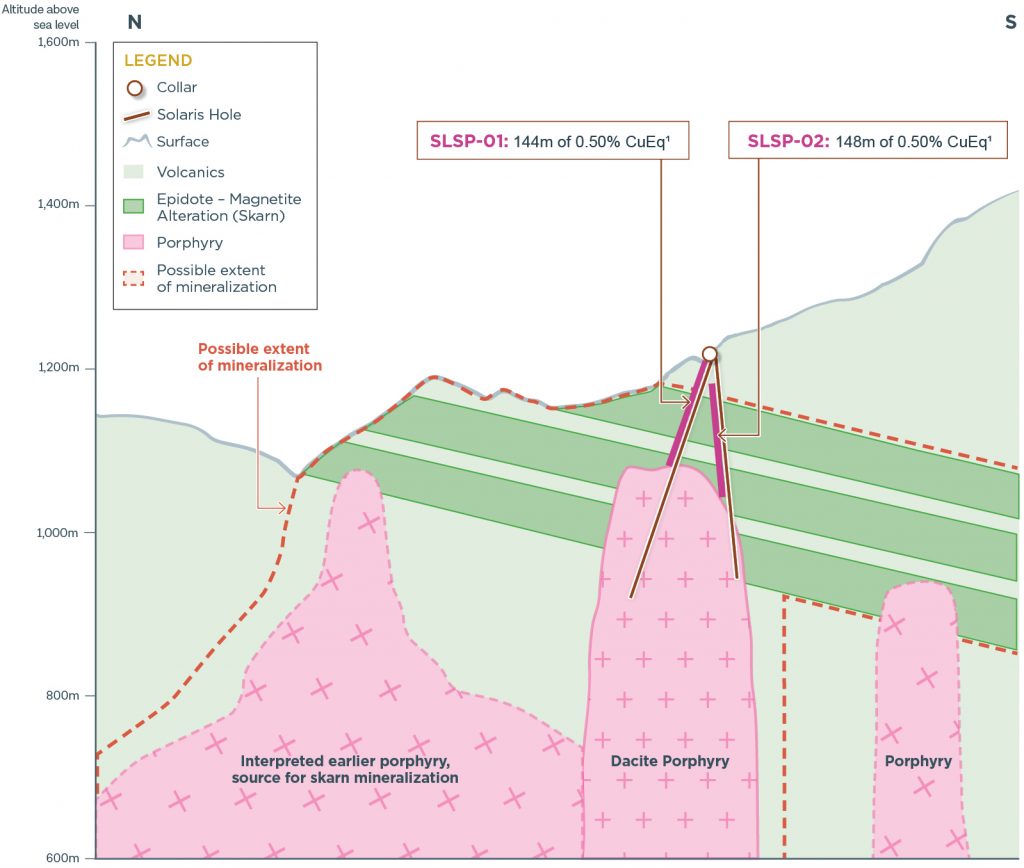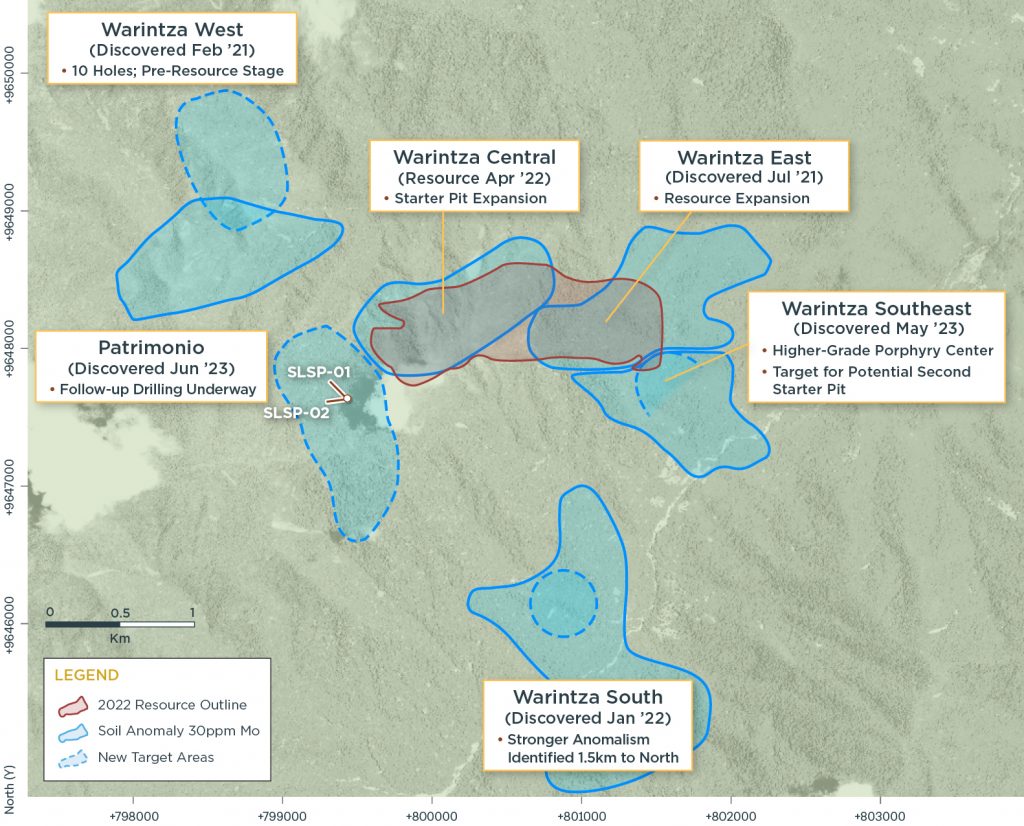
Solaris Resources (TSX:SLS) has reported assay results from its initial two reconnaissance drill holes at the Patrimonio target located within the Warintza Project in southeastern Ecuador. These results solidify the finding of a substantial new copper deposit southwest of Warintza Central.
The Patrimonio discovery was made in June 2023 during a mapping and sampling initiative in proximity to Warintza Central, specifically about 0.5 km to its southwest. These early drill holes have now confirmed the existence of this notable copper reserve. Furthermore, a unique skarn mineralization has been observed within volcanic sequences rich in carbonate. The source of this mineralization is still under investigation.
Details regarding the drilling specify that hole SLSP-01, drilled in a northwest direction, unveiled 50m of 0.75% CuEq¹ and 96m of 0.59% CuEq¹ within a larger span of 144m of 0.50% CuEq¹ from the surface. This was prior to its entry into a mildly mineralized dacite porphyry stock. On the other hand, hole SLSP-02, drilled westward from an identical platform, indicated 148m of 0.52% CuEq¹ inside a more expansive range of 276m of 0.40% CuEq¹ near the surface, culminating in the porphyry.
Two unique mineralization phases have been identified. The first is evident in the upper sections of the holes, showcasing potent epidote-magnetite (skarn) alterations and secondary biotite (potassic) alterations within a series of volcanic structures. The subsequent phase is linked with a later-developing dacite porphyry influenced by quartz-sericite-pyrite alteration which intersects the mineralization in the aforementioned volcanic segments.
Insights gathered from the drill core imply that the epidote-magnetite (skarn) mineralization has origins different from the dacite porphyry, suggesting a captivating possibility for unveiling more skarn mineralization or even its intrusive source within the Patrimonio anomaly.
Furthermore, the later dacite porphyry-influenced quartz-sericite-pyrite alteration possesses around 10% sulphides, primarily pyrite, surpassing chalcopyrite. This indicates potential for similar target settings in other porphyries within the Warintza cluster, where favourable sulphide layers associated with earlier alteration phases are dominated by chalcopyrite over pyrite.

Current efforts are in place for meticulous mapping and sampling to understand this mineral system better and to determine directions for skarn and alteration layers. This will also assist in setting priorities for drill locations that are presently in the construction phase. The copper mineralization is still not fully explored towards the northwest, south, and west, while it touches a slightly mineralized quartz-monzodiorite porphyry on its northeast side.
Patrimonio is characterized by a north-south molybdenum soil anomaly that measures approximately 1.5km x 0.5km, surrounded by a copper soil anomaly extending towards the west. Here, outcropping porphyry shows noticeable alteration and veining, situated on the western flank of an assumed major north-south fault close to Warintza Central.
Highlights from the results are as follows:
Table 1 – Assay Results
| Hole ID | Date Reported | From (m) | To (m) | Interval (m) | Cu (%) | Mo (%) | Au (g/t) | CuEq¹ (%) |
| SLSP-01 | Sep 12, 2023 | 16 | 160 | 144 | 0.34 | 0.03 | 0.09 | 0.50 |
| Including | 16 | 112 | 96 | 0.43 | 0.03 | 0.11 | 0.59 | |
| Including | 62 | 112 | 50 | 0.58 | 0.03 | 0.11 | 0.75 | |
| SLSP-02 | 18 | 294 | 276 | 0.29 | 0.02 | 0.07 | 0.40 | |
| Including | 42 | 190 | 148 | 0.38 | 0.02 | 0.09 | 0.52 |
Notes to table: True widths of the mineralized zone are not known at this time.
Table 2 – Collar Location
| Hole ID | Easting | Northing | Elevation (m) |
Depth (m) |
Azimuth (degrees) | Dip (degrees) |
| SLSP-01 | 799430 | 9647634 | 1519 | 310 | 315 | -60 |
| SLSP-02 | 799430 | 9647634 | 1519 | 310 | 260 | -65 |
Notes to table: The coordinates are in WGS84 17S Datum.
Endnotes
- Copper-equivalence calculated as: CuEq (%) = Cu (%) + 4.0476 × Mo (%) + 0.487 × Au (g/t), utilizing metal prices of US$3.50/lb Cu, US$15.00/lb Mo, and US$1,500/oz Au, and assumes recoveries of 90% Cu, 85% Mo, and 70% Au based on preliminary metallurgical test work.



 Follow us on Twitter
Follow us on Twitter Become our facebook fan
Become our facebook fan










Comments are closed.